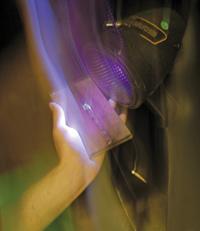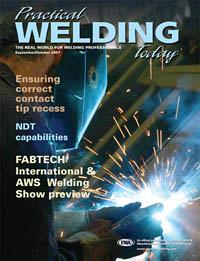- FMA
- The Fabricator
- FABTECH
- Canadian Metalworking
Categories
- Additive Manufacturing
- Aluminum Welding
- Arc Welding
- Assembly and Joining
- Automation and Robotics
- Bending and Forming
- Consumables
- Cutting and Weld Prep
- Electric Vehicles
- En Español
- Finishing
- Hydroforming
- Laser Cutting
- Laser Welding
- Machining
- Manufacturing Software
- Materials Handling
- Metals/Materials
- Oxyfuel Cutting
- Plasma Cutting
- Power Tools
- Punching and Other Holemaking
- Roll Forming
- Safety
- Sawing
- Shearing
- Shop Management
- Testing and Measuring
- Tube and Pipe Fabrication
- Tube and Pipe Production
- Waterjet Cutting
Industry Directory
Webcasts
Podcasts
FAB 40
Advertise
Subscribe
Account Login
Search
Seeing the light with NDT
Precision welding shop expands services, opens door to new business
- By Kristi Nelson
- September 11, 2007
- Article
- Testing and Measuring
Aircraft manufacturers like Boeing and Airbus are continually increasing the requirements for nondestructive testing (NDT), even for non-flight-critical systems and parts. While the testing ensures the structural integrity of each part, it also can create major bottlenecks in the fabrication production process.
Manufacturers already have mandated AS9100 accreditation for their suppliers. As they move closer toward mandatory 100 percent inspection, high-precision-welding shops like Superior Joining Technologies, Machesney Park, Ill., have had to adapt. Thom Shelow, company president, said that for certain customers, each weld must be checked with this process.
In 2006 the company developed a plan to address these concerns by incorporating NDT into its range of services. The company now is able to turn what once was a two-week process into one that takes a few hours. It now has the capabilities it needs to attract new customers and break into new industries.
Removing Resistance
While Superior Joining Technologies concentrates heavily on gas tungsten arc welding (GTAW) as its core competency while outsourcing other services, Shelow said he realized from the beginning that NDT was a potential add-on service.
"We recognized the value of bringing this in-house early on and always knew it had potential to complement our existing services."
Nondestructive testing allows fabricators and manufacturers to establish the weld's internal integrity without actually destroying the welded component. Liquid penetrant testing is one of the most widely used NDT methods because it provides rapid and reliable visual evidence of cracks, porosity, and other defects.
Test objects are cleaned thoroughly and then coated with a visible or fluorescent dye solution. After time is allowed for the solution to penetrate surface cavities, the excess is removed and a developer is applied. The developer acts as a blotter, drawing out the penetrant trapped in voids. With visible dyes, the color contrast between the penetrant and the developer indicates the presence and location of flaws. With fluorescent dyes, an ultraviolet lamp allows technicians to readily see the imperfection.
Eighty percent of Superior Joining's customer base is aerospace-related, and much of that work requires NDT. "With just existing business, we knew we had one-third to one-half of the amount of work we needed to justify purchasing equipment and hiring staff," Shelow said.
However, one program in particular pushed the company into action. Tank weldments, fabricated for one of its aerospace customers, required testing at four different intervals throughout the production process. By adding NDT services in-house, Shelow knew he could shrink the two-week process down to a few hours' turnaround. "To perform at peak, the timing was good to get this program started," he said.
Joining the Pieces
Because of its aerospace industry focus, the company chose fluorescent penetrant dye as the start-up product in its NDT service offerings. Shelow said the company's focus on dye penetrant inspections was driven by customer requirements.

Fluorescent penetrants are used to reveal cracks, pinholes, or other defects that become visible when irradiated with black light.
Once that decision was made, the company purchased needed equipment, brought in a Level III inspector to consult, and began its search for a Level II NDT technician. Finding the right person for that job proved to be the most challenging part of bringing the service in-house. With a limited supply of qualified people in the area, the company started its search locally, then quickly expanded regionally and nationally.
Shelow said it was important to find an individual who was able to multitask. He needed a person to handle the administrative part, work with the consultant to make sure everything is in place, work with customers, as well as actually process the work.
Shelow also knew that the service could potentially become a stand-alone business with two to three operators working around the clock. The person hired would need to adapt to a changing and expanding role quickly. After some false starts and the help of a search firm, the company was finally ready to move forward.
With the hiring of Joel Mohnacky, an American Society for Nondestructive Testing-certified Level II technician with a background in the aviation industry, the company had its systems and personnel in place. The next step was going through the process of getting final authorization from customers.
"Our customers still needed to come in and authorize us to do their parts," said Shelow. "Once we had that approval, we could start building some case history that would allow us to go after additional business."
Identifying some of those new markets and business opportunities was another area where Mohnacky could assist the company. A business degree, along with experience as a licensed pilot, flight instructor, and mechanic with the authority to pilot and sign off on airworthiness of airplanes, has given him a well-diversified network within the industry.
The company is currently pursuing approval from the Federal Aviation Administration (FAA) for repair station status. "That's something different than what our local competitors offer," Shelow said.
Responding to Feedback
The company is already thinking ahead about potential expansion of its NDT services. Depending on market requirements, those services could include magnetic particle inspection, ultrasonic testing, and eddy current testing.
"Our focus on dye penetrant inspections was driven by our customer requirements," said Shelow. "As we begin to expand our service in the business community, we will be responding to new customer demands."
In the meantime Shelow is confident that offering a combination of services will go a long way toward recapturing work that is currently leaving the area. "We'll be able to attract work from bigger companies in town who may be sending work out, plus we'll be more successful in partnering with new businesses," he said.

High-precision-welding shops like Superior Joining Technologies have had to adapt to increased NDT requirements.
Superior Joining's existing customers are already benefiting from one-stop shopping. Previously the company handled the outsourcing of testing for many of its customers. What they do notice is faster turnaround, which Shelow said is the biggest benefit for them as well.
Demand for NDT Technicians Outpacing Supply
Finding a Level II technician proved to be the most challenging part of bringing NDT services in-house at Superior Joining Technologies. That difficulty has prompted President Thom Shelow to explore the possibility of partnering with educational institutions in the community to train future NDT professionals. However, the shortage of NDT technicians is not just a local phenomenon.
Stricter requirements in the aerospace industry, as well as the expanded use of robotics and automation in manufacturing, have increased demand for NDT professionals. At the same time, not enough people are entering the field.
"Right now the industry has almost 3,500 more jobs than trained professionals to fill them," said Michael P. Serabian, president of PQNDT Inc., a Waltham, Mass.-based personnel recruitment and placement agency for the NDT industry.
This situation may not change any time soon. PQNDT's 2006 salary survey found that the average age of NDT professionals is 41.5.
"It shows a definite maturing of the NDT work force," said Serabian. "That's a good thing in terms of experience and professionalism, but as NDT workers continue to age, is there sufficient young talent coming up behind them to fill a growing need?"
For those thinking of entering the field, the future looks quite bright. According to PQNDT's survey, the average annual salary for NDT professionals in the U.S. is $65,701, with Level III professionals averaging $75,883. Additional facts gleaned from the survey include:
- The number of NDT technicians in the field has increased steadily.
- The aerospace industry employs 10 percent more Level IIs than it did in 2004.
- 30 percent of all NDT professionals work in aerospace.
- 46 percent of all NDT professionals are Level II technicians.
- Certifications make a difference in wages; a Level III earns almost twice as much as a Level I.
About the Author
About the Publication
subscribe now

The Welder, formerly known as Practical Welding Today, is a showcase of the real people who make the products we use and work with every day. This magazine has served the welding community in North America well for more than 20 years.
start your free subscription- Stay connected from anywhere

Easily access valuable industry resources now with full access to the digital edition of The Fabricator.

Easily access valuable industry resources now with full access to the digital edition of The Welder.

Easily access valuable industry resources now with full access to the digital edition of The Tube and Pipe Journal.
- Podcasting
- Podcast:
- The Fabricator Podcast
- Published:
- 04/16/2024
- Running Time:
- 63:29
In this episode of The Fabricator Podcast, Caleb Chamberlain, co-founder and CEO of OSH Cut, discusses his company’s...
- Industry Events
16th Annual Safety Conference
- April 30 - May 1, 2024
- Elgin,
Pipe and Tube Conference
- May 21 - 22, 2024
- Omaha, NE
World-Class Roll Forming Workshop
- June 5 - 6, 2024
- Louisville, KY
Advanced Laser Application Workshop
- June 25 - 27, 2024
- Novi, MI
































